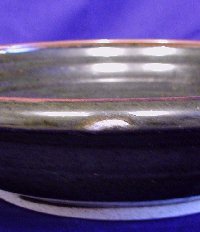...95% is in the material itself
|
Ceramic material purchased in bags has a number of serious problems. The first being expense. Digging up clay and glaze materials is considerably cheaper. A good wage can be made doing pleasant things. Clay as sold in bags and 'ready to use' is much stiffer than potters clay as it has been used for thousands of years. Pots made from this stiff commercial resistant material are stiff and wooden; not plastic, not organic, they do not seem to have grown. The process of throwing is not fun with hard clay. Soft clay is sensuous. tiff clay is hard work; it causes tennis elbow, carpal tunnel problems, it damages arms shoulders and backs. There are now middle aged potters who are looking for new careers. Their bodies have been irreparably damaged. The reason clay has been sold in this form is that modern potters believe than stiff clay will stand up better that soft clay as it is being thrown and that this lack of 'slump' is important because of the relatively low skill levels of modern potters. They are wrong about the slumping qualities of soft clay. It is about the same. They are not wrong about skill levels. They are not aware that potter's clay has been much softer in previous centuries, they seem to have neither imagination nor a sense of history. Commercially prepared clays whether sold plastic or dry causes glazes to craze. Crazed glazes result when, as the the pot cools in the kiln, the glassy coating shrinks more than the clay it covers. Crazing is a crackle pattern in the glaze which penetrates the clay to a slight degree. A crazed pot has the beginnings of a thousand cracks. Thus a crazed glaze causes a 66% of loss in strength in ceramic pots. A test to prove this:
The strengths will be as follows:
It took me more than twenty years to develop a clay body which fits normal glazes. I was slow. I didn't know where to start or what the questions were. The machinery had to be invented. No one else seemed to know how to use these Saskatchewan clays. All learning is self-education. Teachers are babysitters, ortax eaters, drill sergeants or directors of make work projects. We have no choice, we have to do it ourselves. For that reason I say quarry and develop your material, mix it yourself. I had 120 tons of clay hauled to my yard a few years ago (a lifetime supply). I mix about 5 tons out in my yard each August. I have plenty of time to windsurf during that month. I save $3000.00. It is a pleasent and satisfying way to work. The clay cost one cent per pound. So drive for half a day, dig for half an hour and take home 500 lbs of raw material. Know that pots made with this material will be unique. (Read an article by M. Cardew called Potters and Amateur Potters, a short statement about the irrelevance of self-concious self-expression and the limiting consequences of superficial approaches to work).
Alternatively you can charge into the fray. Bite throats. Enter into competition with some two fingered
Rachmaninoff. Remember however that you will probably lose in what is a profane and uninformed market.
It's so vicious because the stakes are small and the puddle crowded and muddy.
|

